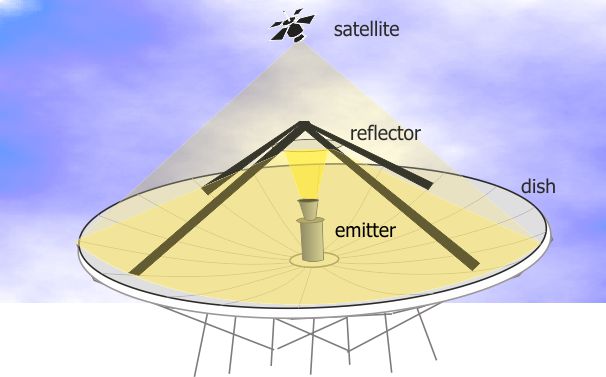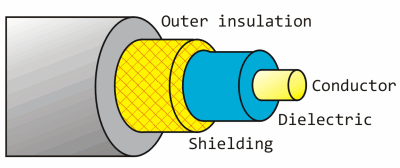Freesat reception - all about dishes
 Brian Butterworth published on UK Free TV
Brian Butterworth published on UK Free TV Satellite reception has both advantages and disadvantages compare with terrestrial (aerial) reception.
By using much higher frequencies (gigahertz, compared to terrestrial televisions megahertz) more transmission channels called transponders (the satellite equivalent of multiplexes) can be provided. For example, there are only six Freeview multiplexes, but Sky or Freesat users can access two hundred satellite transponders.
Aside from exceptional weather conditions (very heavy rain for example) digital satellite provides stable pictures and audio. Where Freeview transmitters are no more than 732 metres above sea level, the geostationary satellites used for television are 35,800,000 metres above the equator so reception is possible even where buildings, trees and hills make terrestrial reception impossible.

The downside of the transmitters being 22,300 miles up in the air is that the signals are very, very weak - so standard TV aerial is of little use. When the signals are sent to the satellites, huge dish transmitters are used to uplink the signal to the satellite. These are tens of metres from side to side, and feature an emitter that generates the signal, which is first bounced of a mirror (called a reflector) and then off the surface of the parabolic dish.

There are many satellites in the sky over the equator. Often these are in clusters over a particular position, for example there are four used for UK television are at 28.2 degrees east. There is another cluster over the 19.2 degrees east positions that are used for German television.
To receive these very weak signals from the satellite, it is necessary to use a dish for reception too. By using a reflective dish, this concentrates the signals onto a small device called a LNB. This is held in front of the dish by a metal arm.

The size of dish for reception is typically much smaller; often 60cm to 100cm in diameter, but the exact size depends upon the transmitting satellite transponder. To keep the transmission power levels down to levels that can be powered by the satellite's solar panels, each beam is focused on a particular area of the Earth's surface. If you are trying to receive the signal at the centre of this zone, a small dish is required. At the outer edges, you may need a 5 metre dish. Maps of these zones are provided by the satellite companies, and are called satellite footprints.
When the dish is installed it must be aligned carefully as the signal is very weak. The installer needs to know the inclination and the azimuth from the ground location to the satellite. If you install yourself you will find that there are markings on the dish that are used to point the dish in the correct position. It is important that the view of the satellite will not be blocked, so must take into account leaves growing on trees and potential building works.
For many people the LNB will have a single cable connected to it, however if you have Sky+ or a multi-room installation the LNB package will actually contain four receivers a quad-LNB. Unlike terrestrial television where you can split the aerial cable to feed more than one Freeview box or television set, with satelite reception you cannot. So, a Sky+ box with two receivers (so you can watch one thing and record another) has two cables connecting the box to the dish.
The cable that connects the dish to the receiver must be satellite grade cable. Whilst this looks superficially like the cable used to connect and aerial to a television, a higher grade cable is required for satellite reception.
Here is an image of a co-axial cable. This sort of cable is used to connect any type of receiving aerial to the reception equipment.

RG6, PF100 and PH100 are all types of coax cable that are suitable for the very weak signals that are received by a satellite dish. (The power is the same as you would receive from a one-bar electric heater on the moon).
The conductor in the centre passes the signals received from the dish to the set-top box. This is made from steel in RG6 cable, and from copper in the RF100 and PH100 types. This makes RG6 less suitable in the UK where rain can damage the cable.
The shielding is responsible for keeping unwanted external interference from damaging the signal. In the cheaper cable this will be a foil wrap, in better specified cables this is a braid (or mesh) of copper wires. The sheild in the RF100 covers 58% of the cable.
The non-conducting layer between the shield and the conductor is called the dielectric. This can be either a solid (RG6), foam (RF100) or air-spaced (PH100) dielectric. This makes the cables progressively more flexible (ie bendy without damage).
10:38 AM
Hi help please I have just converted my garage for my sons and had a quote for a new aerial and booster at £250 the garage is detached from the houes but only by about 3 feet and we have a sky+ setup and dish on our house plus in the loft our old sky box, so could I plug in a new cable from my sky dish and use my old sky box in the garge to get freeview? I really need to run two tvs in the garage so any help much apprecaited we want to key sky plus in the house looking for a cheaper solution than the aerial system
| link to this comment |
3:03 PM
got a letter from the switchover help scheme saying i can have freesat box & sat. dish installed for 56 quid! sounds like the bargain of the year. but i live in Coventry, in a bad reception area, even the freeview is dodgy and breaks up, so my question is would it be possible to pay extra for a double? LNB to have it in the bedroom as well.me and the wife both got this letter if that makes any difference. thanx for any help Don
| link to this comment |
7:27 AM
Bridgnorth
£5.00 on ebay to buy a quad LNB.
Depends on what you want to do. You can connect from your existing digi box aerial output to a TV in your bedroom and watch the programs shown on your main TV, The main tv has to be on the channel that you want to watch in the bedroom. You can switch the main tv off but leave the digi box on.
Alternatively you can install a second aerial lead to your bedroom from a twin LNB to a second digi box in your bedroom to watch programs independantly from your other TV.
There are other alternatives but I choose to explain the easiest.....IANAAT
| link to this comment |
Tom's: mapT's Freeview map terrainT's terrain plot wavesT's frequency data T's Freeview Detailed Coverage
3:03 PM
I have a sky+hd box and sky HD subscription. Does the aerial output from the sky box include a freesat signal that can be fed to a freesat digital box in another room? Or does the sky+HD box filter out the freesat signal?
| link to this comment |
3:06 PM
Thanks for that Tom. Think we might go for the twin lnb to cover both rooms, as its mainly me watching snooker or footer while she has neighbours or corrie. sad really , that what being 80 does for you.btw, can we record in one room while watching another channel in the other?
| link to this comment |
4:23 PM
Hi Briantist,
The local installer has finally got the dish pointing at Astra 2a/b/d and the signal intensity /quality is excellent.
When I tune the receiver I'm only get signal from the transponders on Astra 2a/b.
Looking at the site you directed me to a 60cm dish should do her in Monchegladbach but I think it's larger than that.
Have you any ideas, please.
| link to this comment |
6:48 PM
ChrisR: The Astra 2D satellite's antennas are aimed to, as far as possible, cover only the British Isles. Any spill into Germany is accidental.
However, Monchengladbach is quite far north-west in Germany, so it should be possible to pick it up - with a 90cm dish.
See the 'footprint' at:
ASTRA 2D - SES ASTRA (RG47SH)
| link to this comment |
9:01 PM
Hi I have a sky dish and HD+ box can I use this to receive freesat, if so what do Ineed to do thanks.
| link to this comment |
7:33 PM
Hello, i wonder if you can help! I'm in France, have had a freesat box for about 2 years, set to Astra 2 and all was fine until this afternoon! Not sure why, but i have lost all signal and quality strength? I have checked the dish is still pointing to all the right co-ordinates and it is, pruned a section of a tree that i thought might be a problem and still nothing? It does not appear to be anywhere near a signal, as i'm not seeing the orange bar in either signal or quality strength move at all! Any help / advise would be appreciated.
Thanks
| link to this comment |